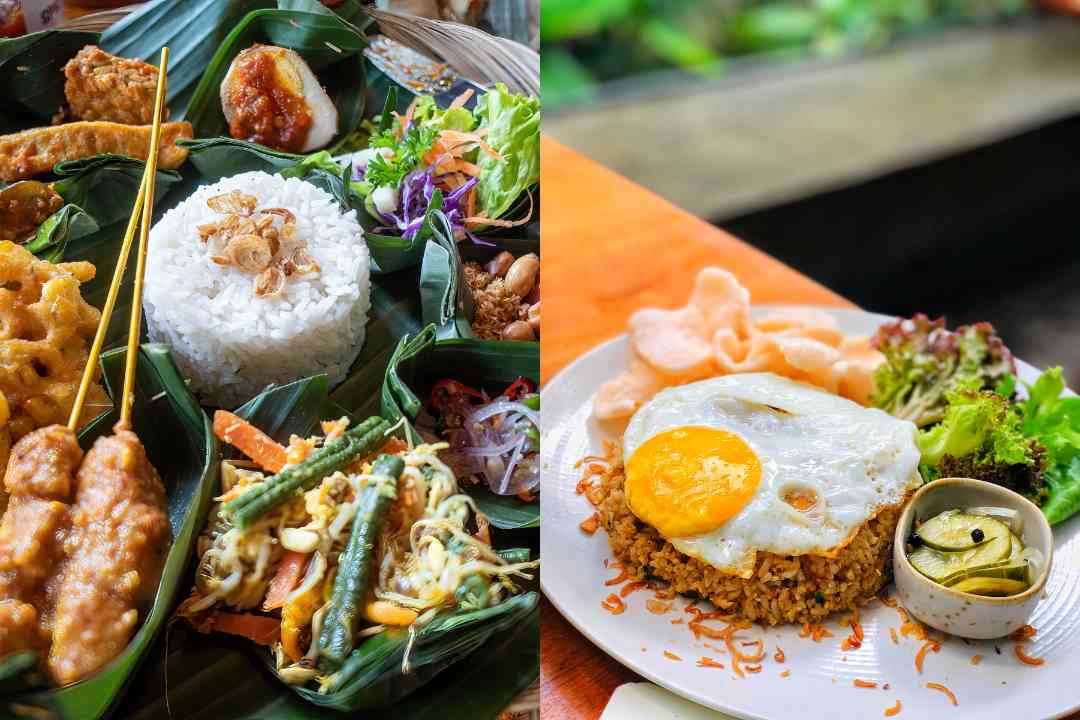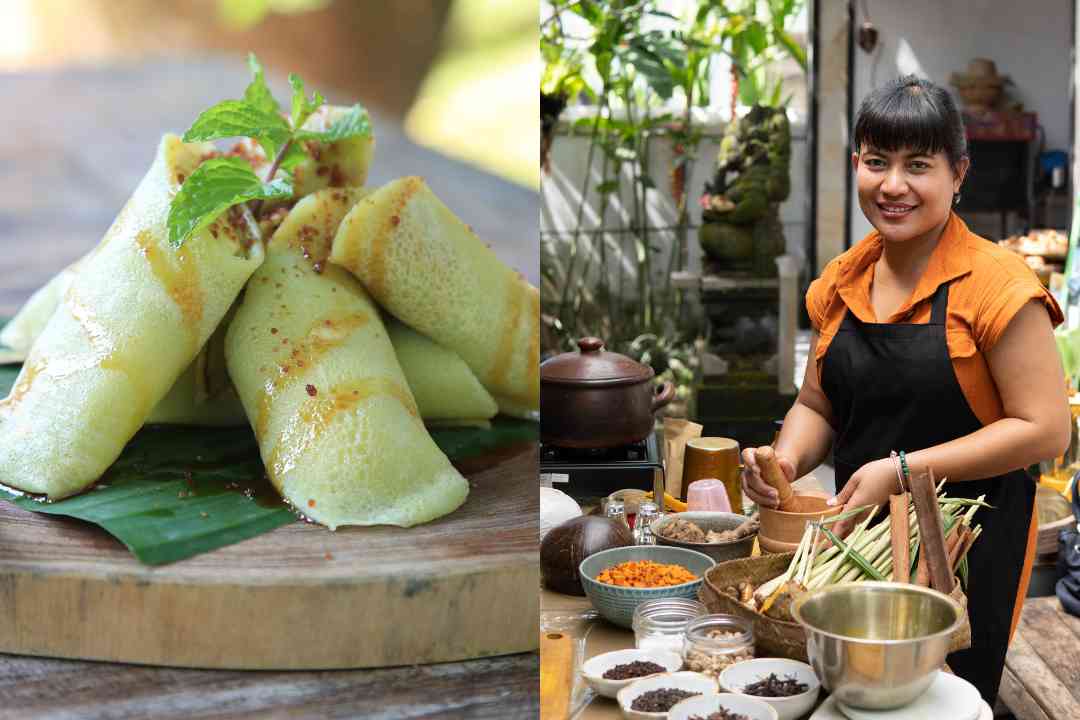Balinese cuisine is more than food—it embodies the soul of the island. While Bali’s beaches and temples may first attract travelers, its cuisine keeps them enchanted long after they leave. Every aroma drifting from a local kitchen carries stories of family, faith, and festivity. From sacred ceremonies to lively street-side warungs, each Balinese dish blends flavor and devotion. Exploring the island through its food means tasting living culture, one bite at a time.
The Soul of Balinese Cooking
At the heart of Balinese cuisine lies a deep connection between people, nature, and the divine. For the Balinese, food represents gratitude and harmony. Every ingredient tells a story about the island’s fertile soil, rich spirituality, and cultural pride.
Moreover, Bali traditional food reflects centuries of creativity and resilience. Cooks combine native island flavors with hints of Indonesian, Indian, and Chinese influence, creating something truly unique. Rice remains the centerpiece of every meal, symbolizing prosperity and life. Around it, chefs craft perfect harmony through five essential tastes: sweet, salty, sour, bitter, and spicy.
Transitioning from one flavor to another, this balance comes alive through aromatic spices such as turmeric, lemongrass, galangal, kaffir lime, garlic, chili, palm sugar, and coconut. Each dish requires patience and passion, often slow-cooked to develop deep, rich flavors that awaken every sense.
Sate Lilit: A Signature of the Island
Among the island’s signature dishes, Sate Lilit stands out as a flavorful icon. Unlike typical Southeast Asian satay, this version uses minced meat—usually fish, pork, or chicken—wrapped around a lemongrass stalk or bamboo stick, then grilled over glowing charcoal. The result is tender, smoky, and irresistibly aromatic.
What makes it special is the bumbu, or spice paste, that defines Balinese ceremonial dishes. Moreover, the paste blends garlic, shallots, galangal, lime leaves, coconut milk, and chili into a fragrant mix that bursts with character. Each family proudly guards its own recipe, often preparing Sate Lilit during celebrations or temple offerings. Ultimately, this dish captures the soul of Balinese cooking—simple, soulful, and filled with heritage.
Nasi Goreng and Nasi Campur: Everyday Favorites
Among Bali traditional food, Nasi Goreng and Nasi Campur stand as local favorites. Nasi Goreng (fried rice) is a comfort dish enjoyed from breakfast to dinner. Cooked with sweet soy sauce, chili, shrimp paste, and topped with a fried egg, it’s both humble and satisfying.
Meanwhile, Nasi Campur — meaning “mixed rice” — is a colorful plate filled with small servings of vegetables, meats, peanuts, and sambal. Each region adds its twist, reflecting the diversity of the island’s culture. Eating Nasi Campur feels like sampling the many faces of Bali in one meal.
Babi Guling: The Taste of Celebration
For grand events, Balinese ceremonial dishes often feature Babi Guling, or roasted suckling pig. Furthermore, this dish symbolizes joy, abundance, and gratitude. The pig is marinated with a blend of turmeric, lemongrass, garlic, and chili, then roasted slowly until the skin becomes crisp and golden.
The preparation is a community affair. Men handle the roasting, while women prepare side dishes and sauces. Served during weddings, temple anniversaries, and festivals, Babi Guling reflects togetherness and celebration. Ubud’s Babi Guling Ibu Oka is one of the most famous places to try this dish.
Sweet Endings: Coconut and Palm Sugar Delights
Balinese sweets are modest but memorable. Using simple local ingredients, they offer comfort with every bite. Try Klepon, green rice flour balls filled with liquid palm sugar and coated in grated coconut. When bitten, they burst with sweetness.
Another favorite is Dadar Gulung, soft pandan crepes filled with coconut and palm sugar. Many cafes now serve Jamu, a herbal tonic made from turmeric and honey, as a refreshing end to the meal. These desserts showcase the natural sweetness of the island and the creativity of Balinese cooks.
Food of the Gods: The Sacred Side of Balinese Cuisine
Balinese food is not just about taste — it’s a spiritual expression. In temples and family compounds, food becomes a sacred offering. Every ceremony, from weddings to cremations, involves careful food preparation, guided by rituals and blessings.
Communities gather to cook together, creating dishes like colored rice, banana leaf parcels, and chicken satay for offerings. These meals are believed to please the gods and bring harmony to the world. In the Balinese Hindu belief, preparing ceremonial food generates positive karma, transforming cooking into a spiritual act.
During grand ceremonies like Galungan and Kuningan, villagers prepare lavish feasts featuring Balinese ceremonial dishes such as nasi kuning (yellow rice with turmeric) and lawar (a mix of vegetables, grated coconut, and spices). Every bite is an offering — a connection between people, nature, and the divine.
Learn and Experience Balinese Cooking
For travelers who want to do more than just taste Balinese cuisine, joining a cooking class is a perfect choice. Moreover, many venues across the island offer hands-on sessions where visitors can learn to prepare Bali traditional food using fresh ingredients from local markets. These classes are designed for everyone — from families looking for a fun cultural activity, to company groups seeking a team-building retreat, or solo travelers who want an authentic local experience. Guided by local chefs, participants can discover the secrets behind Balinese ceremonial dishes, from making spice pastes to creating beautiful offerings that celebrate the island’s culinary soul.
Modern Expressions of Tradition
As Bali continues to welcome the world, its culinary heritage evolves. Modern chefs reinterpret traditional dishes with elegance while preserving their essence. Upscale restaurants in Ubud, Seminyak, and Canggu offer innovative versions of bebek betutu (slow-cooked duck), lawar, and sate lilit. Yet, even with modern presentation, the heart of Bali traditional food remains — strong flavors and spiritual connection.
Cooking classes are now popular among travelers, providing a hands-on experience with local ingredients. Participants learn not only how to cook but also why food matters deeply in Balinese culture. It’s an intimate journey that transforms how visitors see and taste the island.
A Journey Beyond Taste
To experience Balinese cuisine is to experience Bali itself — its devotion, warmth, and rhythm of life. Each meal tells a story, each spice a memory. Whether you’re eating in a simple roadside warung or a seaside restaurant, you’ll feel the same spirit of hospitality and heritage that defines the island.
Food in Bali is more than flavor — it’s culture, faith, and family combined into one unforgettable journey.






Comment (0)